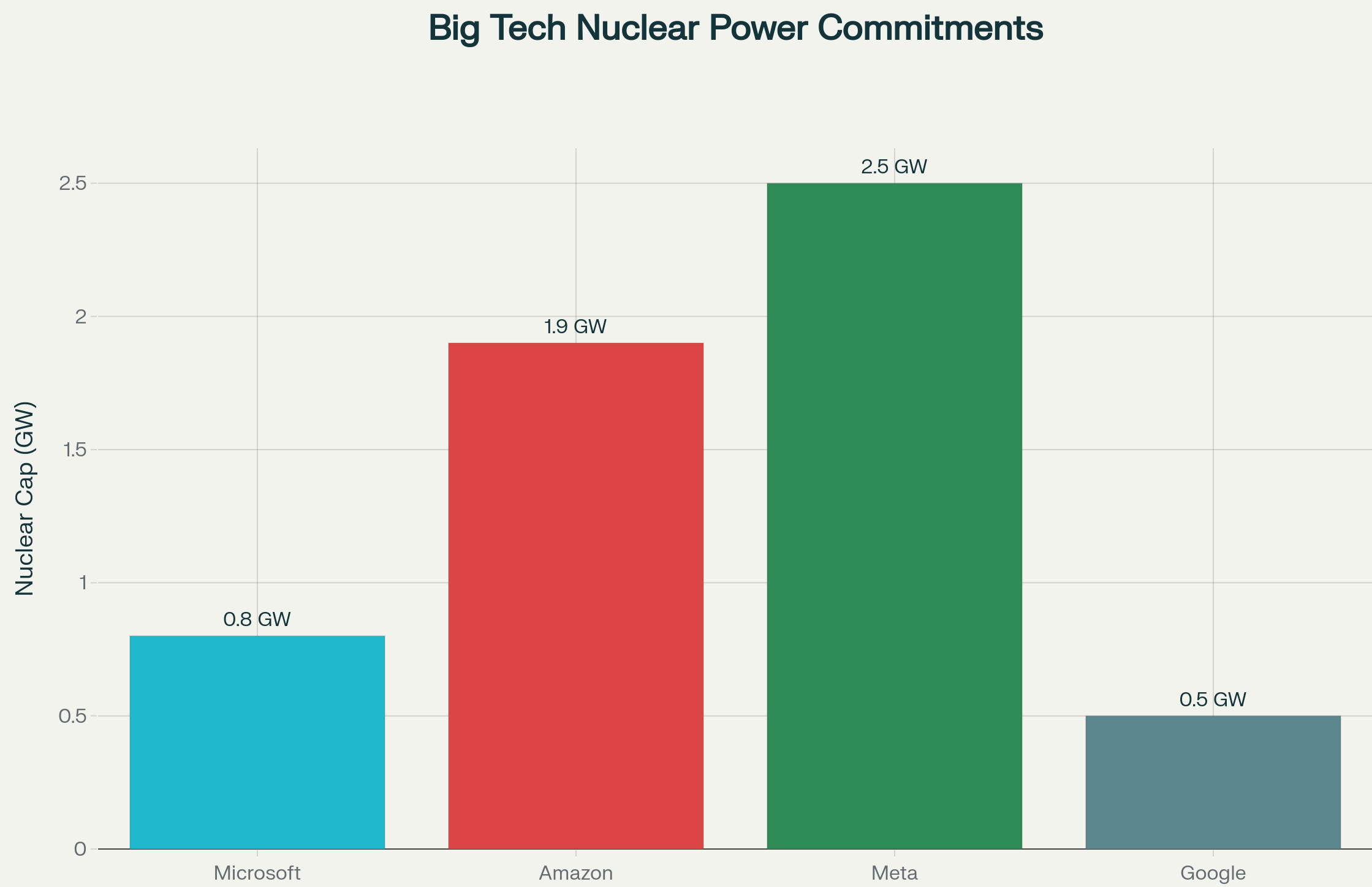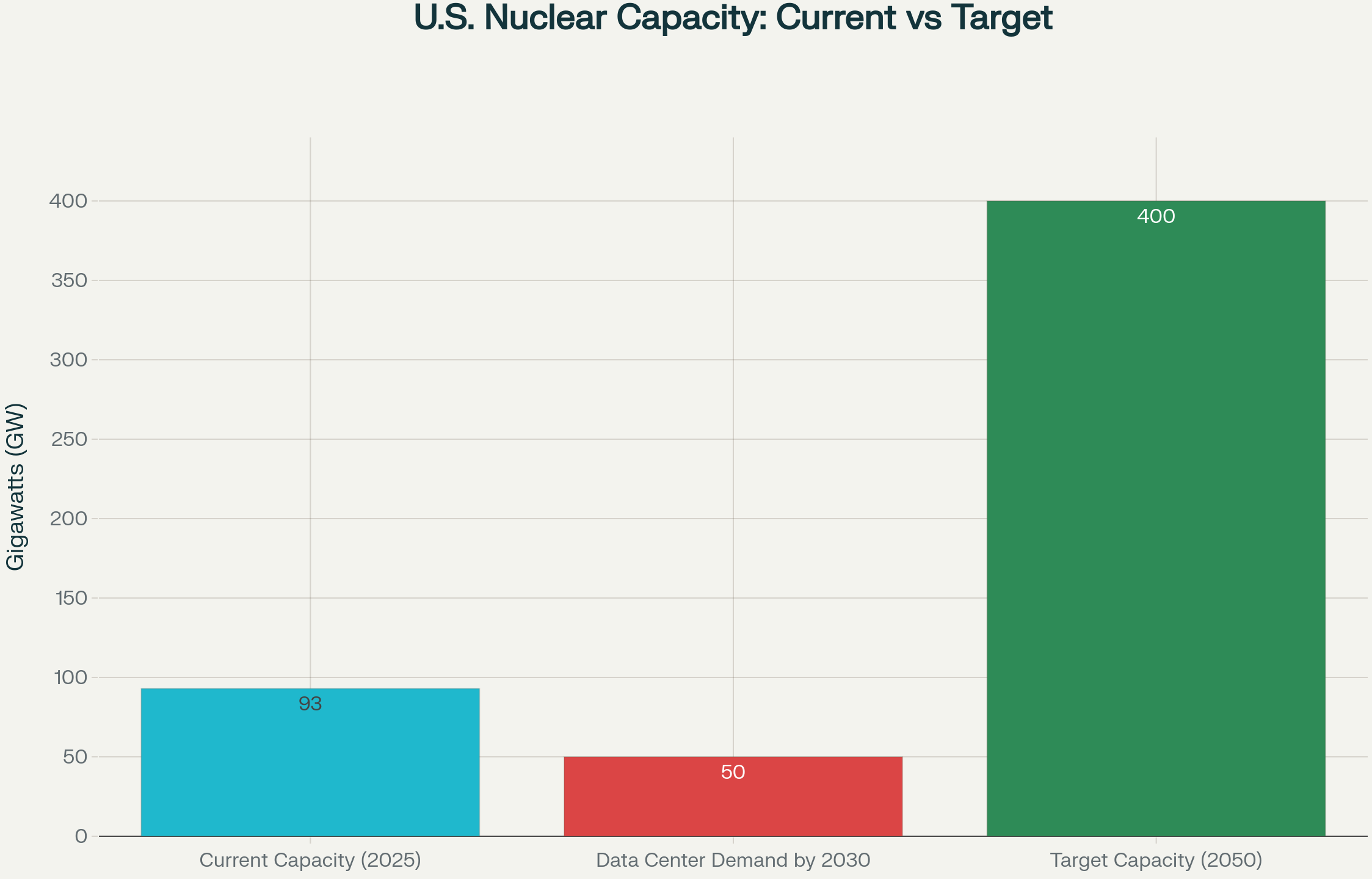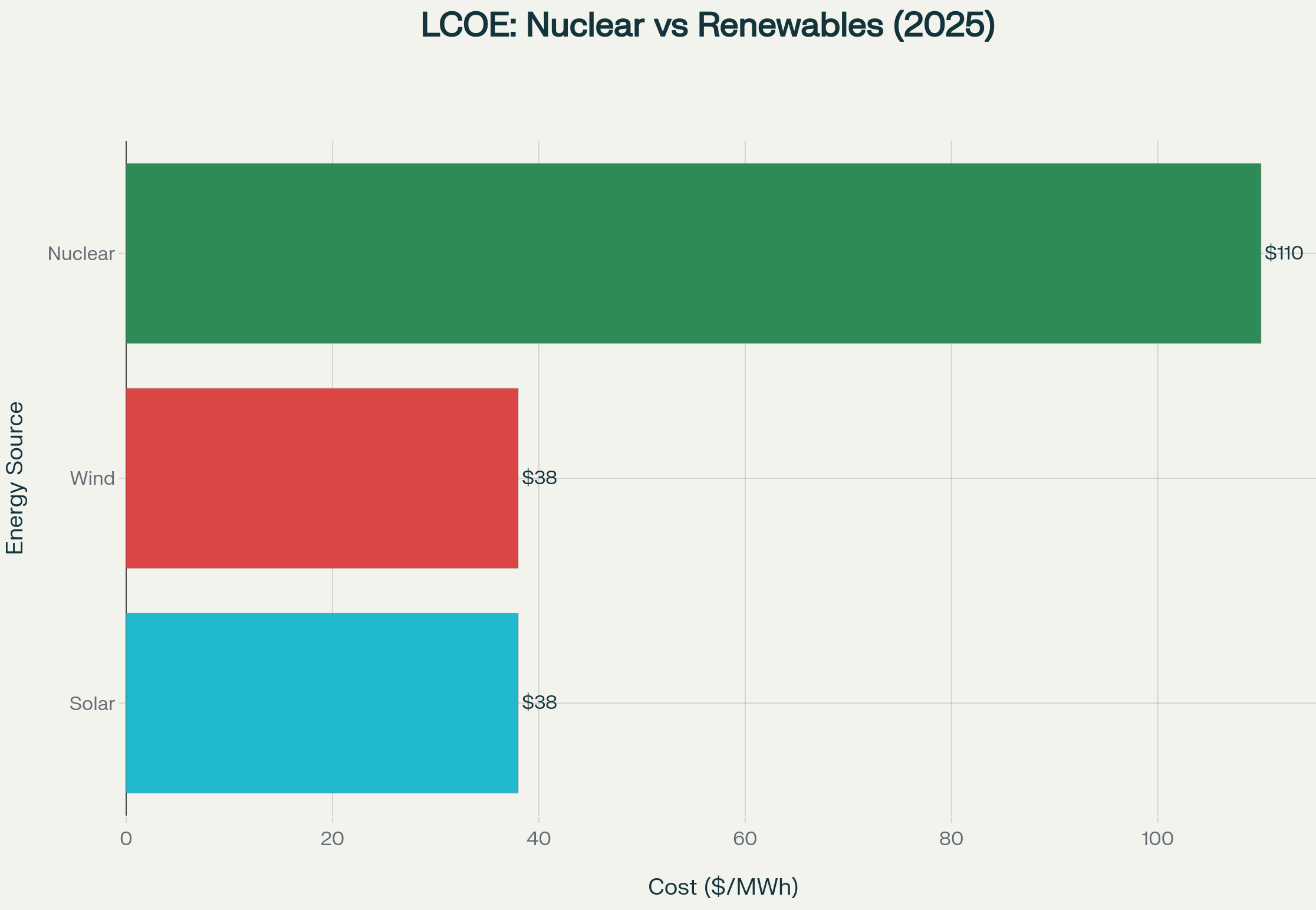TSX jumps amid Fed rate cut hopes, ongoing U.S. government shutdown
Nuclear energy stocks surged 40% year-to-date through 2025 as technology giants, including Microsoft (NASDAQ:MSFT), Amazon (NASDAQ:AMZN), and Google (NASDAQ:GOOGL) signed multibillion-dollar power agreements to fuel AI data centers. Nuclear operators and uranium producers are seeing their strongest growth cycle in decades.
This is due to generative AI, which consumes 10 times more energy than traditional web searches. Trump administration policies are targeting a quadrupling of U.S. nuclear capacity to 400 gigawatts by 2050. Technology companies are projected to invest $250 billion in AI infrastructure in 2025 alone, with Microsoft allocating $80 billion. The result? Urgent demand for reliable baseload power that intermittent renewables can’t match.
Corporate Nuclear Agreements Reshape Energy Landscape

Corporate demand driving the nuclear renaissance, with Amazon and Meta (NASDAQ:META) leading commitments at 1.9 GW and 2.5 GW respectively. These agreements represent billions in private capital flowing into nuclear infrastructure.
Microsoft’s landmark deal with Constellation Energy (NASDAQ:CEG) to restart Pennsylvania’s Three Mile Island Unit 1 by 2027 changed the game. The facility will generate over 800 megawatts of carbon-free electricity exclusively for Microsoft’s data centers over 20 years. First time a technology company has financed reactor restart costs.
Amazon moved aggressively into nuclear with $1 billion in commitments, including a 1.9-gigawatt power purchase agreement with Talen Energy’s (NASDAQ:TLN) Susquehanna plant. Google partnered with Kairos Power to deploy small modular reactors (SMRs) this decade, while Meta committed to sourcing 1-4 gigawatts of new nuclear capacity. Nuclear power has gone from a regulatory burden to a competitive necessity for AI leadership.
Policy Tailwinds Accelerate Development
President Trump’s four executive orders signed in May 2025 mandate regulatory reform, expedited licensing, and major federal support for nuclear infrastructure. The Department of Energy relaunched its $900 million SMR support program and is actively facilitating reactor restarts and power uprates. Pretty sharp reversal from decades of nuclear stagnation.
The urgency stems from alarming grid reliability projections. The DOE’s July 2025 report warns that blackout risks could increase 100-fold by 2030, with annual outage hours potentially soaring from single digits to over 800 hours. Data centers alone require an additional 50 gigawatts by 2030, while 104 gigawatts of firm baseload generation face retirement. Nuclear power’s 95%+ capacity factors make it well-suited to fill this reliability gap.

This chart illustrates the massive expansion required to meet the Trump administration’s 2050 target, showing current capacity at 93 GW needs to quadruple to 400 GW, with an additional 50 GW needed just for data centers by 2030.
Investment Opportunities Across the Nuclear Value Chain
Constellation Energy (CEG) has emerged as the primary beneficiary, with shares gaining 475% over three years. As America’s largest nuclear operator with over 20 reactors, Constellation secured high-profile agreements with Microsoft, Meta, and the U.S. government worth over $1 billion. The company’s recent $26.6 billion acquisition of Calpine expands its portfolio into power-hungry Texas and California markets. Management expects strategic partnerships to lift annual earnings growth from 10% to 13% through 2030.
Uranium miners face a structural supply deficit. Global demand is projected to nearly double to 300-350 million pounds over 15 years, while current production sits at only 150 million pounds annually. The math here is pretty straightforward. Cameco Corp (NYSE:CCJ), the world’s second-largest producer, owns 70% of the McArthur River mine and acquired Westinghouse Electric, giving it exposure across the full nuclear fuel cycle.
NexGen Energy (NYSE:NXE) offers pure-play uranium development with its flagship Arrow deposit in Canada’s Athabasca Basin, some of the highest-grade resources globally. Energy Fuels (NYSE:UUUU), America’s largest conventional uranium producer, benefits from domestic energy security priorities while diversifying into rare earth element processing.
Small modular reactor developers represent the technology frontier, though execution risks remain elevated. Nuscale Power (NYSE:SMR) leads with regulatory approvals and secured its second NRC design approval in 2025. Its 77-megawatt modules can be configured in arrays for flexible deployment. Oklo (NYSE:OKLO) targets microreactors with its 75-megawatt Aurora powerhouse, offering "power-as-a-service" that eliminates upfront capital requirements. The company has secured 14 gigawatts in contracted orders, including 12 gigawatts for data center operator Switch.
Contrarian Case: Renewable Competition and Execution Risk
Nuclear enthusiasm aside, there are real headwinds here. Construction costs for new nuclear facilities range from $15-28 billion per gigawatt based on recent international experience, far exceeding initial projections. NuScale’s cancelled Idaho SMR facility saw costs balloon from $3.6 billion to $9.3 billion before termination. If memory serves, this has been the story with nuclear for decades now.
Solar and wind power now cost $26-50 per megawatt-hour, undercutting nuclear’s $80-140 per megawatt-hour levelized costs. Battery storage costs have plummeted below $300 per kilowatt-hour in 2025, with projections reaching $147-243 per kilowatt-hour by 2035. Renewable energy paired with storage could provide grid reliability at lower costs than nuclear baseload power.
Nuclear waste management remains unresolved, with the U.S. lacking permanent geological storage for high-level radioactive waste. Current on-site storage creates long-term liabilities and security concerns that could impact future economics. Utility-scale battery installations like Abu Dhabi’s planned 5-gigawatt solar facility with 19 gigawatt-hours of storage show renewable-plus-storage scalability.

Key economic challenge facing nuclear power: its cost premium over renewables. At approximately $110/MWh, nuclear is nearly three times more expensive than solar and wind at $38/MWh, providing important context for the contrarian perspective in the article.
Forward Outlook: Different This Time?
The nuclear renaissance looks driven by fundamentals different from previous false starts. Past cycles were about environmental concerns. This one? Urgent economic and security needs from technology companies requiring reliable baseload power for AI.
The convergence of AI demand, supportive policy, and corporate commitment (technology giants are willing to finance reactor restarts and sign 20-year power agreements) suggests this cycle has a stronger commercial foundation than regulatory mandates alone. Question is whether these economics can overcome nuclear’s historical tendency toward cost overruns and delays.
The next five years will determine whether America’s nuclear renaissance delivers sustainable growth or joins previous revivals that failed to materialize. For investors accepting high execution risk and long development timelines, the potential rewards from successful nuclear transformation could be large. Key catalysts to monitor include Three Mile Island’s 2027 restart timeline, SMR construction cost trajectories, and uranium supply responses to rising demand.
Nuclear’s transformation from stagnant utility business to growth industry supported by technology giants creates opportunities worth watching. But distinguishing legitimate nuclear plays from speculative vehicles requires careful analysis of project economics, regulatory pathways, and management execution capabilities. The sector demands patience and risk tolerance. For those willing to wait, the payoff from powering AI’s energy-intensive future could reshape portfolios over the coming decade.
